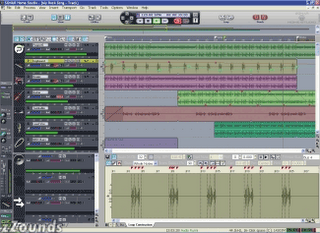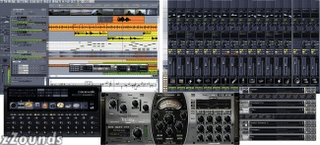Cakewalk's SONAR is a full featured recording/editing/mixing program that is easy to use but very powerful. I use SONAR Producer for producing music for films because the producer's version supports a video track, and SONAR works well with timecode and MIDI. In my opinion, it's the easiest to learn and most intuitive program on the market right now. I can whole-heartedly recommend any of the versions of Sonar.
Sonar is available in three versions. As you can see from the screenshots, they are very similar programs. Screenshots are from zZounds.com.
Producer ($399 as of this writing)
Sonar Producer Edition pretty much has it all! It can record up to 64 bit, 500kHz and has a 64 bit audio processing engine. It supports over 30 surround sound setups and has a very nice surround panner setup that makes surround mixing painless. Producer is the only version that supports a video thumbnail track, essential for film and video work. It also supports many formats of surround mixing. 31 audio plugins and 5 virtual instruments are included. To get a great deal on Sonar Producer Edition, visit zZounds.com
Studio ($299 as of this writing)
Home Studio XL ($199 as of this writing)

Home Studio XL supports 64 tracks of 24 bit, 192 kHz audio. Home Studio XL doesn't have all the professional features of Studio and Producer, but can handle most home recording tasks with lots of power to spare. It does come with 15 audio and 9 MIDI effects. I would recommend this version to most home recordists. To get a great deal on Sonar Home Studio XL, visit zZounds.com
Home Studio ($99 as of this writing)
 Home Studio is the same as Home Studio XL, only does not include the extra effects. To get a great deal on Sonar Home Studio, visit zZounds.com
Home Studio is the same as Home Studio XL, only does not include the extra effects. To get a great deal on Sonar Home Studio, visit zZounds.com


